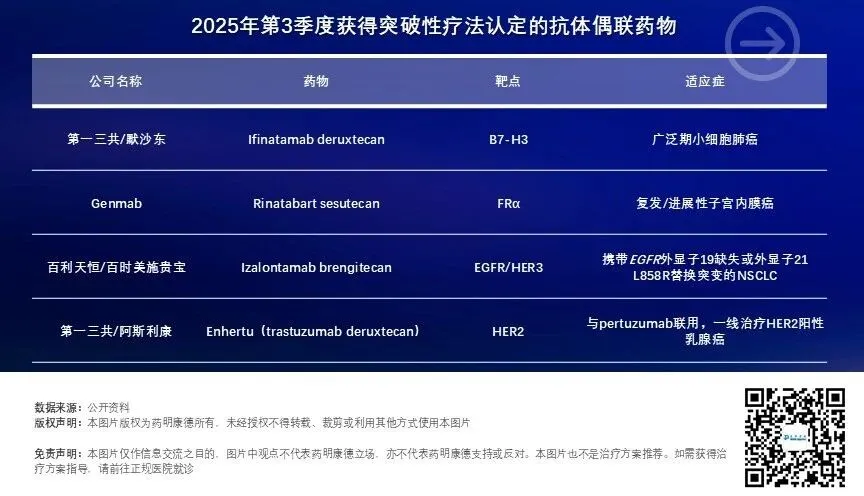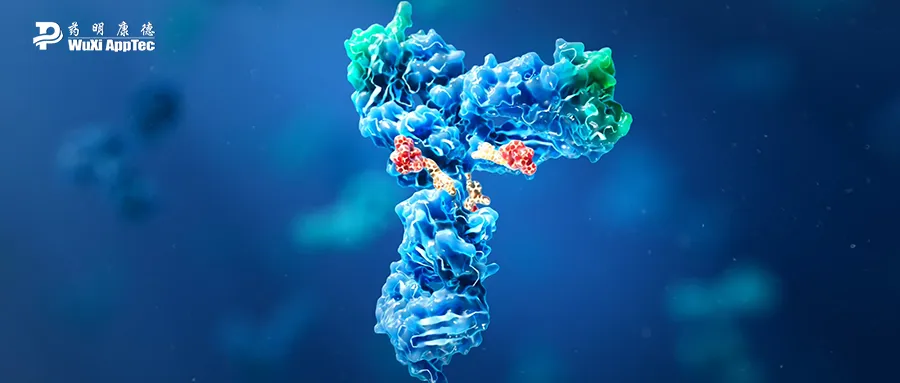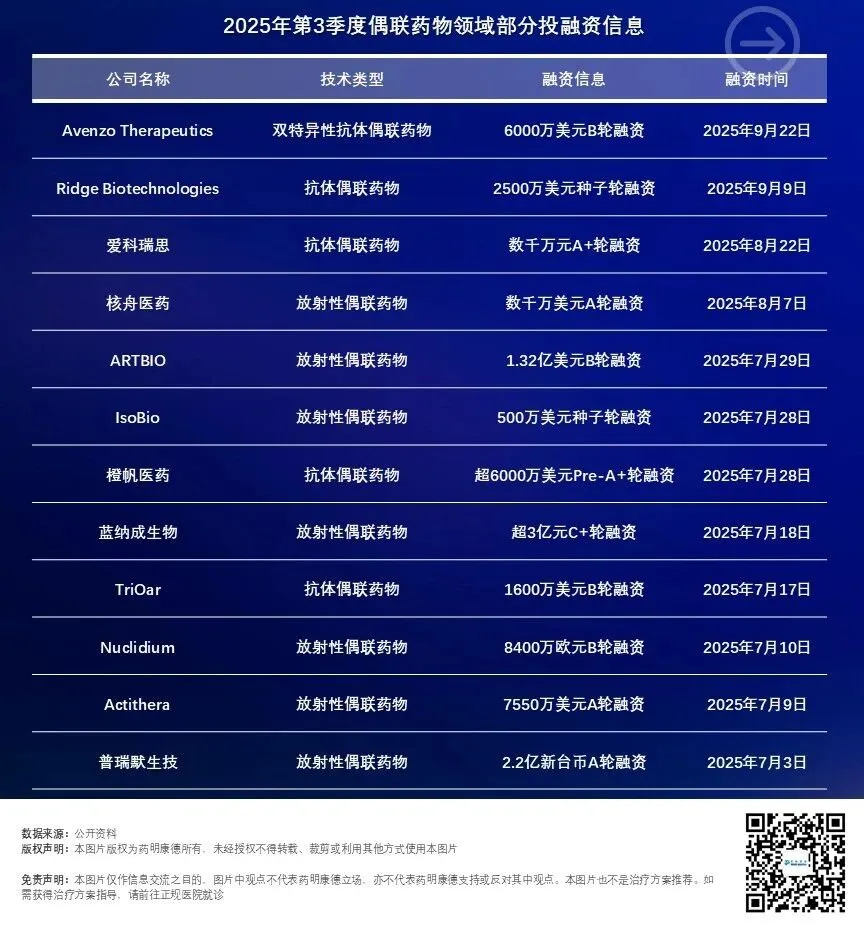 产业资讯
产业资讯
 药明康德
药明康德  2025-09-30
2025-09-30
 473
473
编者按:偶联药物通过将与靶蛋白结合的配体与功能性载荷连接,实现向特定组织或细胞精准递送载荷的效果。近年来,这一领域快速发展,据统计,2024年全球启动了284项抗体偶联药物(ADC)临床试验,比2023年增加了100多项,彰显了偶联药物领域的迅猛增长。ADC之外,放射性偶联药物(RDC)、多肽偶联药物(PDC)以及寡核苷酸偶联药物等新兴偶联模式也不断涌现。药明康德旗下WuXi TIDES搭建了为寡核苷酸、多肽及复杂化学偶联药物开发提供一体化服务的CRDMO平台,覆盖从药物发现、CMC开发及商业化生产的全生命周期,尤其借助药明康德在化学业务方面的丰富经验,为赋能新一代偶联疗法奠定了坚实基础。本文将盘点2025年第三季度(Q3)偶联领域的最新进展,并介绍WuXi TIDES一体化CRDMO平台赋能多肽偶联药物开发的能力。
抗体偶联药物:多款疗法获FDA突破性疗法认定,双特异性ADC崭露头角
2025年第三季度,多款创新ADC获得FDA授予的突破性疗法认定,这一认定旨在加快治疗严重疾病创新疗法的开发和审评,初步临床证据显示它们与已有疗法相比在具有临床意义的终点方面提供显著改善。
获得突破性疗法认定的ADCs既包括已获批的重磅药物,也涵盖靶向新靶点的潜在“first-in-class”疗法,还包括一款双特异性ADC。这也是双特异性ADCs首次获得FDA授予的突破性疗法认定。

▲2025年第三季度获得FDA突破性疗法认定的ADCs(数据来源:公开资料,截至9月22日)
双特异性ADCs通过靶向两个不同靶点,或者同一靶点上的两个不同表位,与只与单个靶点接合的ADCs相比,可能增加与靶细胞接合的特异性,从而提高疗效并降低脱靶效应带来的潜在毒性。此外,靶向不同靶点蛋白可能让双特异性ADCs与更为广泛的细胞群体结合,从而克服肿瘤的异质性。
这一领域正在得到业界越来越多的关注,在2025年Q3,多家公司在双特异性ADC领域取得进展。例如,百利天恒与百时美施贵宝(Bristol Myers Squibb)联合开发的靶向EGFR和HER3的潜在“first-in-class”双特异性ADC izalontamab brengitecan在治疗鼻咽癌的3期临床试验中,中期分析达到主要终点。在今年9月的世界肺癌大会(WCLC)上公布的数据显示,剂量为2.5 mg/kg的izalontamab brengitecan与EGFR抑制剂Tagrisso作为一线组合疗法,在治疗携带EGFR突变的非小细胞肺癌(NSCLC)患者的2期临床试验中,达到100%的客观缓解率(ORR)和95%的确认ORR,12个月无进展生存率为92.1%。
康方生物的AK146D1是一款靶向Trop2和Nectin4的双特异性ADC,它在今年7月完成1a期临床试验的首例患者给药。Avenzo Therapeutics和映恩生物联合开发的EGFR/HER3靶向ADC AVZO-1418也完成1/2期临床试验的首位患者给药,用于治疗晚期实体瘤。
天演药业与ConjugateBio公司在今年7月达成研发合作,ConjugateBio将利用天演药业开发的独有双特异性抗体进行双特异性ADC项目的开发。Radiance Biopharma则在9月与科弈药业达成研发和许可合作,共同开发潜在“first-in-class”靶向c-MET和EGFR的在研ADC RB-601(KY-0301)。

在Q3 2025,多款靶向单一靶点的创新ADC也获得积极临床进展。例如,默沙东(MSD)与第一三共(Daiichi
Sankyo)联合开发的B7-H3靶向ADC ifinatamab
deruxtecan在治疗广泛期小细胞肺癌(ES-SCLC)的2期临床试验中表现出48%的确认ORR和87.6%的疾病控制率(DCR)。
由PD-1抑制剂Keytruda与抗体偶联药物Padcev构成的组合疗法,作为围手术治疗方案,在治疗患有肌层浸润性膀胱癌(MIBC)且不适合使用以顺铂为基础化疗的患者的3期临床试验中,与单纯手术相比,在主要终点无事件生存期(EFS),以及关键次要终点总生存期(OS)和完全病理学缓解率(pCR)方面均取得了具有统计学意义和临床意义的改善。
BioNTech和映恩生物联合开发的HER2靶向ADC trastuzumab pamirtecan在治疗经治HER2阳性乳腺癌的关键性3期临床试验中,与活性对照ADC相比,在预定的期中分析中达到无进展生存期的主要终点。
多家偶联药物新锐完成融资,放射性偶联药物备受关注
2025年第三季度,偶联药物领域的多家新锐陆续完成融资,为持续推动这一治疗模式的创新提供了强劲动力。其中,放射性偶联药物公司的表现尤其亮眼,在第三季度至少有7家专注于RDC药物开发的公司完成融资。例如ARTBIO在7月底宣布完成1.32亿美元B轮融资,获得资金将用于加速公司α粒子放射性配体疗法的开发进程。其针对转移性去势抵抗性前列腺癌的候选药物AB001已进入临床开发阶段。

▲2025年第三季度偶联药物领域部分投融资活动(数据来源:公开资料,截至9月22日)
虽然RDC在早期肿瘤成像和治疗方面均展现巨大潜力,但其药物结构复杂,通常由靶向配体、连接子、螯合剂和放射性同位素组成。其生产过程需要多学科的专业技术支持。药明康德综合性的放射性药物发现平台整合了多肽发现和放射性药物开发能力,提供包括多肽合成、螯合剂合成、放射性标记、成像、药理学研究和监管申报支持等完善的服务。一体化平台让多个团队并行攻坚、高度协作,帮助合作伙伴快速推动RDC项目,节省宝贵的开发时间。药明康德旗下WuXi TIDES CRDMO平台目前正在赋能各类偶联药物开发,覆盖多种疾病领域。
回顾2025年第三季度,偶联药物领域在临床进展以及投融资方面都取得了可圈可点的进展。期待随着偶联技术的持续创新和优化,催生更多造福患者的突破。WuXi TIDES团队将继续利用其一体化的CRDMO平台赋能偶联药物的开发,帮助合作伙伴将科学创新早日转化成让全球患者获益的疗法。
CRDMO: Q3 2025 Review of Conjugated Therapeutics
Conjugated drugs enable the precise delivery of therapeutic payloads to specific tissues or cells by linking target-binding ligands with functional payloads. In recent years, this field has advanced rapidly. According to a recent report, 284 antibody-drug conjugate (ADC) clinical trials were initiated globally in 2024—over 100 more than in 2023. Alongside ADCs, new conjugated modalities have also gained momentum, including radionuclide drug conjugates (RDCs), peptide-drug conjugates (PDCs), and oligonucleotide-drug conjugates. This growing momentum underscores the expanding potential of conjugated therapeutics in addressing a broad range of diseases.
Backed by extensive experience in chemistry and integrated drug development expertise, WuXi TIDES is supporting next-generation conjugated therapies. As an integral part of WuXi AppTec, WuXi TIDES has built an integrated CRDMO platform focused on oligonucleotides, peptides and related synthetic conjugates. This platform simplifies TIDES drug development by providing all discovery, CMC development and the entire manufacturing supply chain under one roof.
Antibody-Drug Conjugates: Multiple Therapies Receive FDA Breakthrough Therapy Designation
In the third quarter of 2025, several innovative ADCs received Breakthrough Therapy designation (BTD). This designation is intended to expedite the development and review of treatments for serious diseases when preliminary clinical evidence indicates a substantial improvement on clinically meaningful endpoints over available therapies.
Among the ADCs granted BTD are an approved blockbuster medicine, potential "first-in-class" therapies that target novel antigens, and one ADC designed to engage two antigens. Notably, this quarter marks the first time the FDA has awarded BTD to a bispecific ADC.
Bispecific ADCs can engage two distinct targets—or two different epitopes on the same target—thereby increasing tumor-cell binding specificity relative to single-target ADCs. This enhanced selectivity may translate into improved efficacy and reduced off-target toxicity. In addition, by recognizing different antigens, bispecific ADCs may address a broader spectrum of tumor cells, helping to overcome intratumoral heterogeneity.
Reflecting the growing interest in this modality, several bispecific ADC programs reported progress during Q3 2025. For example, izalontamab brengitecan, a potential "first-in-class" EGFR/HER3-targeting bispecific ADC, met the primary endpoint at interim analysis in a Phase 3 trial for nasopharyngeal carcinoma. Data presented at the World Conference on Lung Cancer (WCLC) in September also showed that izalontamab brengitecan at a dose of 2.5 mg/kg, combined with Tagrisso as a first-line therapy, achieved an objective response rate (ORR) of 100% and a confirmed ORR of 95% in a Phase 2 trial for patients with EGFR-mutant non-small cell lung cancer (NSCLC), with a 12-month progression-free survival (PFS) rate of 92.1%.
In addition, a Trop2/Nectin-4 bispecific ADC and an EGFR/HER3-targeting ADC both completed the dosing of first patients in their first-in-human clinical trials.
In July, Adagene entered into an R&D collaboration with ConjugateBio, under which ConjugateBio will leverage Adagene’s proprietary bispecific antibodies to develop bispecific ADC programs. In September, Radiance Biopharma reached a research and licensing collaboration with Novatim Immune Therapeutics to jointly develop RB-601 (KY-0301), a potential "first-in-class" investigational ADC targeting c-MET and EGFR.
In Q3 2025, several innovative single-target ADCs also achieved encouraging clinical progress. For example, ifinatamab deruxtecan, a B7-H3-targeted ADC, demonstrated a confirmed ORR of 48% and a disease control rate (DCR) of 87.6% in a Phase 2 trial for extensive-stage small cell lung cancer (ES-SCLC).
The combination therapy of the PD-1 inhibitor Keytruda with the ADC Padcev, as a perioperative treatment, showed statistically and clinically meaningful improvements compared with surgery alone in a Phase 3 trial in patients with muscle-invasive bladder cancer (MIBC) who are ineligible for cisplatin-based chemotherapy. The improvements were seen in the primary endpoint event-free survival (EFS), as well as the key secondary endpoints overall survival (OS) and pathologic complete response (pCR).
Finally, trastuzumab pamirtecan, a HER2-targeted ADC, met the primary endpoint of progression-free survival in a pre-specified interim analysis of a pivotal Phase 3 trial in previously treated HER2-positive breast cancer, compared with an active control ADC.
Sustained Innovation: Emerging Players Secure New Financing
In Q3 2025, several emerging companies in the conjugate-therapy space completed new financing rounds, supporting continued innovation in this modality.
Financing activities in RDC developers were especially prominent during Q3 2025, with at least seven companies completing rounds ranging from seed to Series C+, reflecting investors’ interest in different stages of RDC companies. Targeted alpha-particle therapies (TAT) continue to emerge as a focal point. TAT leverages the unique properties of alpha particles—such as high linear energy transfer (LET) and short tissue penetration—to deliver potent cytotoxic effects to cancer cells while minimizing damage to surrounding healthy tissue.
Although RDCs have demonstrated potential in early tumor imaging and treatment, their complex drug structures—typically composed of a targeting ligand, linker, chelator, and radionuclide—require multidisciplinary technical expertise for development and manufacturing. WuXi AppTec offers a comprehensive radiopharmaceutical discovery platform that combines peptide discovery with radiopharmaceutical development, covering peptide synthesis, chelator synthesis, radiolabeling, imaging, pharmacology studies, and regulatory filing support. This integrated model enables parallel, highly collaborative efforts across multiple teams, helping partners accelerate RDC programs and save valuable development time.
In summary, Q3 2025 has seen remarkable progress in the conjugated drug field across clinical milestones and financing activities. As innovation and optimization in conjugation technologies advance, the field is poised for even more breakthroughs that promise to benefit patients worldwide.
WuXi TIDES remains committed to harnessing its fully integrated CRDMO platform to support the development of conjugated drugs—empowering partners to accelerate the translation of scientific innovation into transformative therapies.

 产业资讯
产业资讯
 新药猎人笔记
新药猎人笔记  2025-11-24
2025-11-24
 50
50

 产业资讯
产业资讯
 细胞基因治疗前沿
细胞基因治疗前沿  2025-11-24
2025-11-24
 52
52

 产业资讯
产业资讯
 Medaverse
Medaverse  2025-11-24
2025-11-24
 51
51